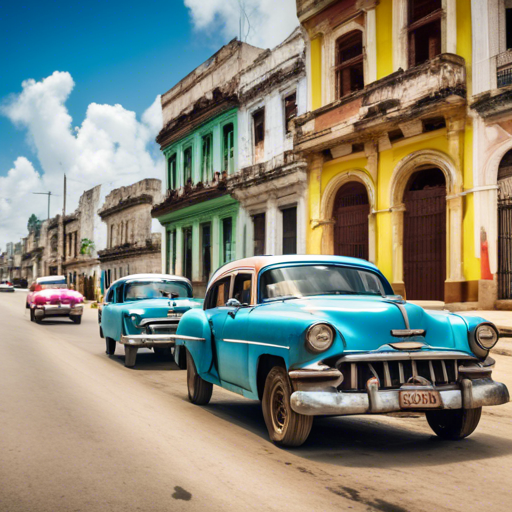exploring cuba's historical milestones and cultural heritage

Exploring Cuba's Historical Milestones and Cultural Heritage
Cuba, an island nation in the Caribbean, is renowned for its rich history and vibrant culture. From its colonial past to its revolutionary milestones, Cuba offers a unique blend of historical and cultural experiences. In this article, we delve into the key historical events that have shaped Cuba and explore its diverse cultural heritage.
Historical Milestones
Understanding Cuba's history is essential to appreciate its present. The island's past is marked by significant events that have left an indelible mark on its identity.
Colonial Era
The colonial era began with the arrival of Christopher Columbus in 1492. Cuba became a Spanish colony, and this period was characterized by the establishment of plantations and the introduction of African slaves. The colonial architecture, still visible in cities like Havana and Trinidad, reflects this era.
- 1492: Columbus lands in Cuba.
- 1511: Spanish colonization begins.
- 1886: Abolition of slavery.
Independence and Republic
The struggle for independence from Spain culminated in the Spanish-American War in 1898. The Treaty of Paris ended Spanish rule, and Cuba became a U.S. protectorate until it gained formal independence in 1902. The early 20th century saw the establishment of the Cuban Republic, marked by political instability and economic dependence on the United States.
- 1898: Spanish-American War.
- 1902: Cuban independence.
- 1952: Batista's coup d'état.
The Cuban Revolution
The Cuban Revolution of 1959, led by Fidel Castro, Che Guevara, and others, was a turning point in the island's history. The revolution resulted in the overthrow of the Batista regime and the establishment of a socialist state. This period saw significant social and economic changes, including land reforms and nationalization of industries.
- 1953: Moncada Barracks attack.
- 1959: Triumph of the Cuban Revolution.
- 1961: Bay of Pigs Invasion.
Cultural Heritage
Cuba's cultural heritage is a vibrant tapestry woven from various influences, including indigenous, African, Spanish, and American elements. This cultural diversity is evident in the island's music, dance, art, and cuisine.
Music and Dance
Cuban music is world-renowned, with genres like son, salsa, and mambo originating from the island. The rhythms and melodies reflect a fusion of African and Spanish influences. Dance is an integral part of Cuban culture, with styles such as rumba, cha-cha-cha, and the internationally famous salsa.
- Son: A blend of Spanish guitar and African percussion.
- Salsa: A lively dance genre that has gained global popularity.
- Rumba: A traditional Afro-Cuban dance.
Art and Literature
Cuban art and literature have flourished despite political and economic challenges. The island has produced renowned artists and writers who have made significant contributions to global culture. The works of José Martí, a national hero and literary figure, and the vibrant visual arts scene in Havana are testament to Cuba's rich artistic heritage.
- José Martí: Poet, essayist, and national hero.
- Wifredo Lam: Influential painter known for his Afro-Cuban themes.
- Alejo Carpentier: Novelist and musicologist.
Cuisine
Cuban cuisine is a delightful blend of Spanish, African, and Caribbean flavors. Traditional dishes such as ropa vieja, a shredded beef stew, and moros y cristianos, a rice and black beans dish, are staples of Cuban gastronomy. The island's culinary heritage is celebrated in its vibrant street food culture and family-run paladares (private restaurants).
- Ropa Vieja: Shredded beef stew.
- Moros y Cristianos: Rice and black beans.
- Tostones: Fried plantains.
Conclusion
Cuba's historical milestones and cultural heritage offer a fascinating glimpse into the island's unique identity. From its colonial past to its revolutionary present, Cuba continues to captivate the world with its rich history and vibrant culture. For those interested in exploring more about Cuba, consider visiting this travel resource for additional insights and travel tips.
FAQ
| Question | Answer |
|---|---|
| What are the key historical events in Cuba? | The arrival of Columbus in 1492, the Spanish-American War in 1898, and the Cuban Revolution in 1959 are some of the key historical events. |
| What are some traditional Cuban dishes? | Traditional Cuban dishes include ropa vieja, moros y cristianos, and tostones. |
| Who are some famous Cuban artists and writers? | José Martí, Wifredo Lam, and Alejo Carpentier are some renowned Cuban artists and writers. |
| What are popular music and dance styles in Cuba? | Popular music and dance styles in Cuba include son, salsa, and rumba. |
For more information on traveling to Cuba, visit this travel guide.
```